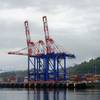Bureau Veritas has improved financial results for the 2002-2003 financial year. Strong growth in both revenues and profits confirm BV's
absolute leadership in this sector.
Turnover, at EUR 1.145bn, was up 13 per cent on 2001. Consolidated operating
profits grew by 22 per cent to EUR 121m. Group post-tax profits surged by
almost 45 per cent to EUR 86m, while total equity is now almost 250 per cent
greater than it was five years ago, thus emphasising the extent to which the
Group has grown and the resources that shareholders contribute to ensure
increased future growth.
BV's marine activity grew by a further eight per cent last year as part of a
continuing upward trend. During 2002, BV's classed fleet grew to a record
6,600 vessels totalling 40m gt, and its share of the world newbuilding
orderbook also grew to over ten per cent, with an especially strong
performance in technology-led sectors such as LNG, passengerships and
chemical tankers.
Bernard Anne, managing director of BV's marine division, says, "These
results are very satisfying, and I am proud of the Marine Division's
contribution to our global growth. Being part of such a strong group allows
us to bring major resources to bear on specific problems in a way others
simply cannot afford. During last year - and it is still ongoing - we have
focused heavily on bulk carrier safety, and on finding practical, workable
solutions within IACS which will have global application and behind which
the industry can unite."
Anne says BV will shortly publish a set of guidelines for bulk carrier
construction. They are aimed at helping owners to decide on structural
configuration and to assist them in negotiations with yards. "We are
concerned that, in the rush towards demanding double hulls for everything,
our political leaders may have lost sight of practicality," continues Anne.
"Double hulls for new tankers are now a fact and have become the standard
design. This concept is now beginning to be applied to bulk carriers. But we
all know that double-hulls are not a panacea and they have pros and cons.
Single-hull bulk carriers can be just as robust, and there are many good
robust ships out there today with a useful life. I would much rather see a
single-hull ship built to high standards and then well maintained by a
quality owner, than have a double-hull ship built down to shipyard minimums,
then maintained at minimum levels.
"We simply don't believe that you can design every problem out of a ship's
structure, as maintenance will always be the key factor in how safe a ship
is as it grows older. Let's take the example of single hull tankers built
between 1986 and 1996 which under the proposals the EU is pushing forward
will face early scrapping in 2010, the youngest being only 14 years old.
Most of them are well built and well maintained by quality owners. We as an
industry should be able to propose new techniques and methods including FEM
calculations and fatigue analysis for assessing the capacity of these ships
to operate in safe conditions up to their normal lifespan. What makes the
real differences between the strength of ships is much more often a matter
of build quality and maintenance than a matter of design. “In BV, we trust in the development of new technologies. Whatever will be
the future design of ships, double or single hull, these developments will
contribute to make safer shipping and this is why, using our financial
strength, we will continue to invest heavily in this field."
Featured videos

Inmarsat Enhances Service to Drive Digitalization

Tracking Foreign Vessels Working in the U.S. Jones Act Market

Inside the Electrified Truckable Tug
Subscribe for
Maritime Reporter E-News
Maritime Reporter E-News is the maritime industry's largest circulation and most authoritative ENews Service, delivered to your Email five times per week








